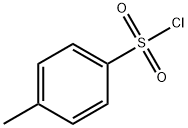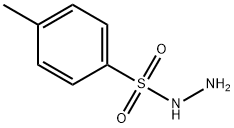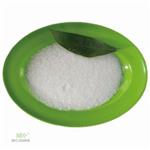Reaction
Tosyl chloride is called "TsCl", with strong nucleophilicity and substitution reaction with nucleophilic reagent. For example, reaction with the alcohol into the ester:
ROH + TsCl-Py → ROTs + Py + HCl-, reaction with amine and hydrazine respectively to generate the sulfonamide and sulfonyl hydrazide:
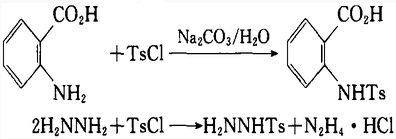
Chemical Properties
White flaky crystal. melting point is 71 ℃. Boiling point is 151.6 ℃ (1.67kPa), 145-146 ℃ (2.0kPa). Soluble in alcohol, ether and benzene, insoluble in water.
Usage
1.Tosyl chloride is an intermediate for disperse dyes, azoic dyes, acid dyes. Also used in the production of drugs homosulfanilamide.
2. Used for the analysis Reagents, but also for organic synthesis, dye preparation and molecule rearrangement in the hormone synthesis.
3. Used for organic synthesis, sulfa drugs and as pesticide intermediates.
Production method
Toluene chlorosulfonation production into o-toluenesulfonyl chloride, at the same time p-toluenesulfonyl chloride is also generated. The filter cake was separated from the o-toluenesulfonyl chloride, refined to obtain p-toluenesulfonyl chloride.
Chemical Properties
White to yellow solid.
Uses
Tosyl chloride (also known as p-Toluenesulfonyl chloride), is used as a precursor in the production of dyes and saccharin. It acts as a dehydrating agent in the conversion of urea to carbodiimide and converts alcohols into the corresponding toluenesulfonate esters. It is also employed as a flow-promoting agent for paints, an adhesive, nitrocellulose, coating material and as a plasticizer for polyamides. Furthermore, it serves as an antistatic agent, as a gloss enhancer in plastic film preparations and as a basic material of electroplating solutions.
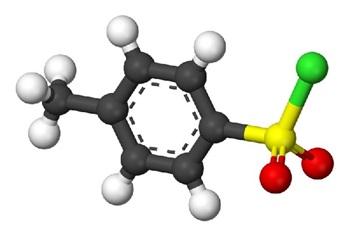
Preparation
Tosyl chloride is a by-product from the production of ortho-toluenesulfonyl chloride (a precursor for the synthesis of the common food additive and catalyst saccharin), via the chlorosulfonation of toluene:
CH3C6H5+ SO2Cl2→ CH3C6H4SO2Cl + HCl
General Description
Tosyl chloride is a white to gray powdered solid with a distinctive odor. It can be used in organic synthesis, to make nitriles, isocyanides and diimides.
Health Hazard
TOXIC; inhalation, ingestion or skin contact with tosyl chloride may cause severe injury or death. Contact with molten substance may cause severe burns to skin and eyes. Avoid any skin contact. Effects of contact or inhalation may be delayed. Fire may produce irritating, corrosive and/or toxic gases. Runoff from fire control or dilution water may be corrosive and/or toxic and cause pollution.
Fire Hazard
Non-combustible, substance itself does not burn but may decompose upon heating to produce corrosive and/or toxic fumes. Some are oxidizers and may ignite combustibles (wood, paper, oil, clothing, etc.). Contact with metals may evolve flammable hydrogen gas. Containers may explode when heated.
Purification Methods
Material that has been standing for a long time contains tosic acid and HCl and has m ca 65-68o. It is purified by dissolving (10g) in the minimum volume of CHCl3 (ca 25mL) filtered, and diluted with five volumes (i.e. 125mL) of pet ether (b 30-60o) to precipitate impurities. The solution is filtered, clarified with charcoal and concentrated to 40mL by evaporation. Further evaporation to a very small volume gives 7g of white crystals which are analytically pure, m 67.5-68.5o. (The insoluble material is largely tosic acid and has m 101-104o.) [Pelletier Chem Ind (London) 1034 1953.] It also crystallises from toluene/pet ether in the cold, from pet ether (b 40-60o) or *benzene. Its solution in diethyl ether has been washed with aqueous 10% NaOH until colourless, then dried (Na2SO4) and crystallised by cooling in powdered Dry-ice. It has also been purified by dissolving in *benzene, washing with aqueous 5% NaOH , then dried with K2CO3 or MgSO4, and distilled under reduced pressure and can be sublimed at high vacuum [Ebel Chem Ber 60 20861927]. [Beilstein 11 IV 375.]
